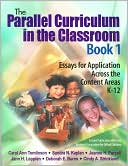List Books » The Parallel Curriculum in the Classroom, Book 1: Essays for Application Across the Content Areas, K-12
Category Books
- Fiction Books & Literature
- Graphic Novels
- Horror
- Mystery & Crime
- Poetry
- Romance Books
- Science Fiction & Fantasy
- Thrillers
- Westerns
- Ages 0-2
- Ages 3-5
- Ages 6-8
- Ages 9-12
- Teens
- Children's Books
- African Americans
- Antiques & Collectibles
- Art, Architecture & Photography
- Bibles & Bible Studies
- Biography
- Business Books
- Christianity
- Computer Books & Technology Books
- Cookbooks, Food & Wine
- Crafts & Hobbies Books
- Education & Teaching
- Engineering
- Entertainment
- Foreign Languages
- Game Books
- Gay & Lesbian
- Health Books, Diet & Fitness Books
- History
- Home & Garden
- Humor Books
- Judaism & Judaica
- Law
- Medical Books
- New Age & Spirituality
- Nonfiction
- Parenting & Family
- Pets
- Philosophy
- Political Books & Current Events Books
- Psychology & Psychotherapy
- Reference
- Religion Books
- Science & Nature
- Self Improvement
- Sex & Relationships
- Social Sciences
- Sports & Adventure
- Study Guides & Test Prep
- Travel
- True Crime
- Weddings
- Women's Studies
The Parallel Curriculum in the Classroom, Book 1: Essays for Application Across the Content Areas, K-12 » (1st Edition)

Authors: Sandra N. Kaplan, Deborah E. Burns, Carol Ann Tomlinson, Jeanne H. Purcell, Jann H. Leppien
ISBN-13: 9780761929727, ISBN-10: 076192972X
Format: Paperback
Publisher: SAGE Publications
Date Published: August 2005
Edition: 1st Edition
Author Biography: Sandra N. Kaplan
Cindy Strickland has been a teacher for 25 years and has worked with students of all ages, from Kindergarten to Master's degree. Cindy's consulting work includes school districts across the US and Canada as well as England, France, and Thailand. In the past seven years, Cindy has provided hundreds of workshops on topics relating to differentiation, the Parallel Curriculum Model, and gifted education.
Cindy's publications include The Parallel Curriculum Model in the Classroom: Applications Across the Content Areas and In search of the dream: Designing schools and classrooms that work for high potential students from diverse cultural backgrounds.
Publications in differentiation include Tools for High Quality Differentiated Instruction: An ASCD Toolkit, the ASCD online course Success with Differentiation, the book Differentiation in Practice: A Resource Guide for Differentiating Curriculum, Grades 9-12, and a unit in the book Differentiation in Practice: A Resource Guide for Differentiating Curriculum, Grades 5-9.
Cindy's honors include the University of Virginia's Curry School Scholarship for outstanding academic and professional potential and the National Association for Gifted Children's Outstanding Doctoral Student Award.
Book Synopsis
Enrich your understanding and application of the Parallel Curriculum Model!
The Parallel Curriculum: A Design to Develop High Potential and Challenge High-Ability Learners remains a groundbreaking publication offering an innovative model for rich curriculum development across varying ability levels. Its four parallel approaches to curriculum development were designed to challenge all students to greater expertise across content areas while helping teachers challenge and develop their own expectations.
The Parallel Curriculum in the Classroom, Book 1 delves more deeply into the classroom application of the Parallel Curriculum Model, providing in-depth examinations of how to:
- Design appropriate curriculum using the Parallel Curriculum Model
- Effectively apply focusing questions when planning for each of the parallels
- Modify the curriculum and classroom environment for students to learn from multiple perspectives
- Extend opportunities with the Curriculum of Identity
- Plan curriculum and instruction using Ascending Intellectual Demand
For teachers, curriculum and instruction directors, staff developers, and administrators, The Parallel Curriculum in the Classroom, Book 1 makes designing and planning with the Parallel Curriculum Model clear. Challenge and reward yourself and your students with this promising new model!
See
Table of Contents
About the Book
Using the Model and Units for Professional Development
Acknowledgments
1. In Praise of Protocols: Navigating the Design Process Within the Parallel Curriculum Model by Deborah E. Burns
Curriculum as a Road Map
The Purpose, Problems, and Process of Curriculum Writing
The Goal and Sequence of This Essay
The Beginning: Agreeing on the Components of a Curriculum Plan
The Challenge of Writing Well-Aligned PCM Curriculum
Supporting the Work of Creative Professionals
The Parallel Curriculum Model Protocols
Conclusion
2. The Importance of the Focusing Questions in Each of the Curriculum Parallels by Jann H. Leppien
The Nature of a Discipline and How It Relates to the Focusing Questions
Early in the Curriculum Planning Process
Using the Core Curriculum's Purpose, Characteristics, and Questions to Guide Curricular Decisions
Using the Curriculum of Connections' Purpose, Characteristics, and Questions to Guide Curricular Decisions
Using the Curriculum of Practice's Purpose, Characteristics, and Questions to Guide Curricular Decisions
Using the Curriculum of Identity's Purpose, Characteristics, and Questions to Guide Curricular Decisions
In Closing
3. Using the Four Parallel Curricula as a Comprehensive Curriculum Model: Philosophy and Pragmatism by Sandra N. Kaplan
The Philosophical Rationale
The Pragmatic Rationale
Conclusion
4. Exploring the Curriculum of Identity in the PCM Model by Jeanne Purcell
What Is the Curriculum ofIdentity?
What's In It for Me?
Conclusion
References
5. Ascending Intellectual Demand Within and Beyond the Parallel Curriculum Model by Carol Tomlinson, Sandra Kaplan, and Kelly Hedrick
What Is Ascending Intellectual Demand?
How Does Ascending Intellectual Demand Relate to Other Guides for Challenge?
How Is Ascending Intellectual Demand Different Than Other Approaches to Challenge?
Using Ascending Intellectual Demand to Plan Curriculum and Instruction
When and Where Do Teachers Apply Ascending Intellectual Demand?
A Word of Caution
Why Does Ascending Intellectual Demand Matter?
References
Index
Subjects
 Special Education
Special Education  Education - Gifted Children
Education - Gifted ChildrenEducation & Teaching
 Teaching & Teacher Training
Teaching & Teacher Training  Teaching - Classroom Planning & Management
Teaching - Classroom Planning & ManagementEducation & Teaching
 Teaching & Teacher Training
Teaching & Teacher Training  Teaching - Curricula
Teaching - Curricula
